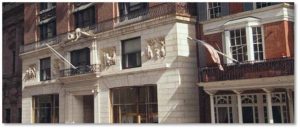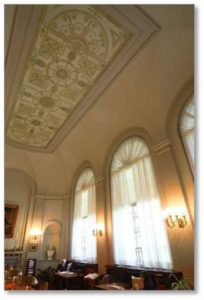When walking city streets you sometimes have to look up to see interesting or unusual things. Most people live at street level hurrying from place to place and rarely raising their eyes above the first floor.
If you don’t look up when you’re passing Congregational House on Beacon Street, however, you will miss four outstanding bas relief-carvings of historical scenes by a sculptor whose work is well-known in Boston. Here’s the story:
The Congregational House Library and Archive
The Congregational Library and Archive, administered by the American Congregational Association (ACA), was founded on May 25, 1853. Originally located in rooms on the corner of Beacon and Somerset streets nearby, the library began with 53 books donated from personal collections.
As the collection grew, it needed a larger building and moved to the present location in 1898. The ACA built a new structure on a parcel of land that was originally part of the Boston Common and later the location of the city almshouse and workhouse.
Designed by Shepley, Ruttan and Coolidge, now Shepley Bulfinch, the building is listed on the National Register of Historic Places and is included in the Park Street Historic District.
The Collection
After 1957 when many Congregational churches joined the United Church of Christ, the library was designated as the records repository for the General Council of the Congregational Christian Churches, the central denominational board of the Congregational church. In addition to these records, numerous associations, organizations and movements from the Congregational tradition, including the Old South Church and the Park Street Church, gave their records to Congregational Library archives. The purpose was to centralize and protect this important historical information.
The library’s rare book section includes a rich and complete assemblage of English and first-generation Puritan works. The current collection of 225, 000 pieces includes such notable items as:
- An early Bible written in Algonquin
- 15,000 sermons dating from the late 1630s
- An original copy of the Cambridge Platform of 1649
- The ledger that records the baptism of Benjamin Franklin in 1706
- The diary and personal documents of Cotton Mather from 1716
- Anti-slavery tracts and temperance treatises
- Buddhist statues originally cataloged as “heathen idols”
The archive also holds oak beams from the church the Pilgrims left behind in England and a chunk of Plymouth Rock. On a more contemporary note, Congregational House was filmed as the location of the law firm of Cage and Fish in “Ally McBeal” as well as the law offices of Jan Schlichtmann in the movie “A Civil Action.”
Domingo Mora’s Bas-Reliefs
Outside, flanking the balcony on the second floor of the Congregational Library are four bas-relief sculptures that “illustrate the core values of the Congregational tradition.” They were carved by Domingo Mora, a sculptor and immigrant from Catalonia who has left his artistic mark in various places around Boston. Mr. Mora also carved the 16 allegorical statues in the John Adams Courthouse and worked on the facade of the Boston Public Library’s McKim Building.
He carved all four historical sculptures on Congregational House from Knoxville marble, which has a delicate, pinkish-gray hue that helps highlight the figures against a colored background. From left to right, the four core values illustrated on the building are:
- Rule Under Law by Consent of the Governed – The Pilgrims signing the Mayflower Compact
- Worship According to Conscience – The Pilgrims’ observance of the Sabbath on Clark’s Island, December 20, 1620
- Education for Leadership – The founding of Harvard College in 1636
- Community Witness or Philanthropy – John Eliot preaching to the Native Americans in the Nonantum settlement in 1642
Because the panels are crowded with figures, it can be difficult from street level to tell what is going on or which is which. Because the building is on the south side of Beacon Street and the facade is often in shadow, the sidewalk on the opposite side of the street provides the best view. Slanting evening sunlight picks out the high-relief figures but also casts dark shadows that obscure others and make photography a challenge. My pictures did not come out well so I assembled this montage from photos on the Internet.
Exploring Congregational House
Inside, the building’s lobby looks like that of any 19th-century commercial building of that time period and only the stairway provides visual interest. The bright and sunny reading room, which is open to the public weekdays from 9 am to 5 pm, faces south. It overlooks Old Granary Burying Ground as does that of the Boston Athenaeum next door.
The Library offers tours of our stacks and archive room, both of which are otherwise closed to the public. For an introductory tour of the library, its history, collections, and services, make a reservation by contacting Claudette Newhall, Librarian, by email, or call 617-523-0470 x 229 to arrange the date and time.
Information and Directions
Congregational House Library and Archive
14 Beacon Street
Boston, MA 02108
617-523-0470
http://www.congregationallibrary.org
 You can find information on library hours and directions on the Congregational House website. The Get Connected page holds Information on arranging tours and their historical site app.
You can find information on library hours and directions on the Congregational House website. The Get Connected page holds Information on arranging tours and their historical site app.




